How do you express your appreciation to the President of the United States? Sending a positive letter is nice. A card or telegram works, too. But 214 years ago, folks in one town devised a unique gift … which turned out to carry malodorous consequences. And it inspired an even bigger, even smellier presidential gift 34 years later, which went on to serve as the inspiration for two episodes of a popular 1990s TV series. That’s a lot of legacy from a single token of appreciation. And here’s how it all started.
Thomas Jefferson had been president for five months by the summer of 1801. And a guy in New England thought he was doing a great job.
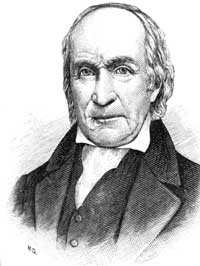 Elder John Leland was a Baptist minister who appreciated Jefferson’s dedication to religious liberty. He wanted to let the president know of his approval.
Elder John Leland was a Baptist minister who appreciated Jefferson’s dedication to religious liberty. He wanted to let the president know of his approval.
Nobody is sure exactly just how the idea struck him, but Elder Leland came up with something that was truly one-of-a kind.
Cheshire, his hometown, is a tiny place in the boonies of western Massachusetts. It was settled by immigrants from Cheshire, England, which is known for the cheddar cheese that’s produced there. English immigrants brought their cheese-making skills with them and kept producing cheddar on this side of the Atlantic.
One day, Elder Leland had a “Eureka!” moment. The town would send a cheddar cheese to the White House.
And not just any old cheese, either. It would be a cheese unlike any other. He recruited the ladies of his congregation to produce what was grandly called the Cheshire Mammoth Cheese.
He pitched the proposal to his flock, inviting everyone “who owned a cow to bring every quart of milk given on a given day, or all the curd it would make, to a great cider mill…” They wound up collecting milk from 900 cows.
 At the mill, a large hoop was placed on an apple cider press. As milk was poured into it, the Baptists sang and prayed and added ingredients.
At the mill, a large hoop was placed on an apple cider press. As milk was poured into it, the Baptists sang and prayed and added ingredients.
They engraved the words “Rebellion to tyrants is obedience to God” on the side. Jefferson liked that line so much he used it on his personal seal. (Ben Franklin had earlier suggested it for the national motto.)
The finished product certainly lived up to its billing. It was mammoth, alright, weighing 1,234 pounds, stretching four feet wide and standing fifteen inches tall. Elder Leland pronounced it “the greatest cheese ever put to press in the New World or Old.”
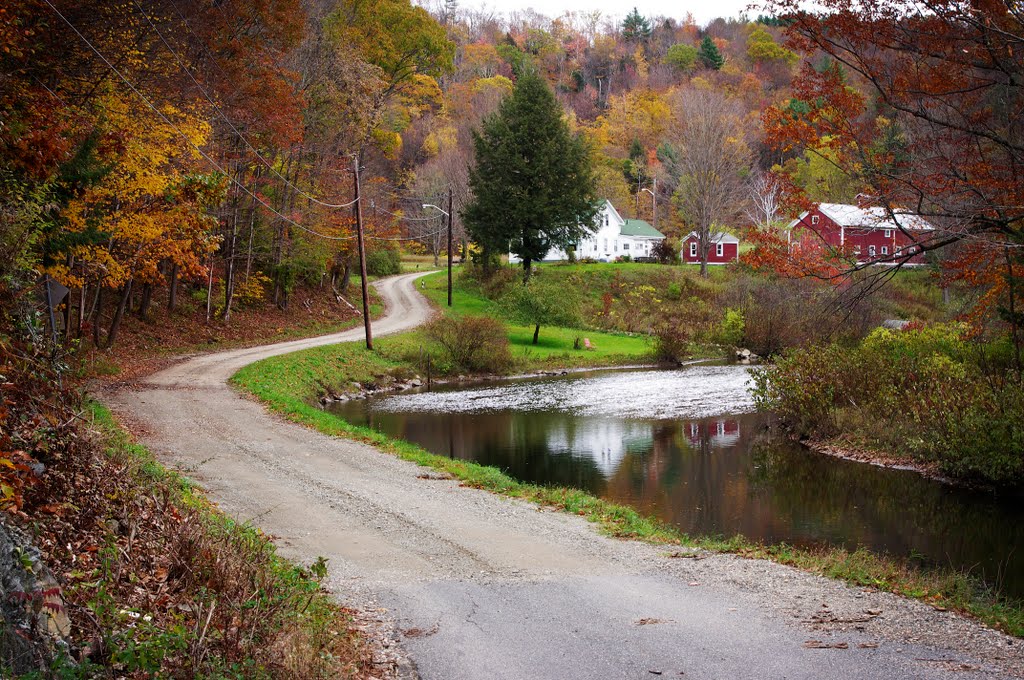 The people of Cheshire had succeeded in creating a honking hunk of cheese. But what next? Making it was one thing; getting it to the White House was something else entirely.
The people of Cheshire had succeeded in creating a honking hunk of cheese. But what next? Making it was one thing; getting it to the White House was something else entirely.
Then Nature came to the rescue.
Winter arrived early that year, and much snow came with it. Late in November, the Cheshire Mammoth Cheese was loaded on a sleigh and dragged to New York City, where it was hoisted onto a ship and taken to Baltimore. A wagon carried it on the final leg of the 500 mile journey, arriving in the capital on December 29, 1801.
 The Baptist elder presented the well-traveled cheese to Jefferson at a brief White House ceremony on New Year’s Day 1802. He praised Jefferson for the “singular blessings that have been derived from the numerous services you have rendered to mankind in general.” He also pointed out the gigantic cheese “was produced by the personal labor of freeborn farmers with the voluntary and cheerful aid of their wives and daughters, without the assistance of a single slave.” (Elder Leland apparently was unaware Jefferson had brought slaves from his home in Virginia to serve him in the President’s House.)
The Baptist elder presented the well-traveled cheese to Jefferson at a brief White House ceremony on New Year’s Day 1802. He praised Jefferson for the “singular blessings that have been derived from the numerous services you have rendered to mankind in general.” He also pointed out the gigantic cheese “was produced by the personal labor of freeborn farmers with the voluntary and cheerful aid of their wives and daughters, without the assistance of a single slave.” (Elder Leland apparently was unaware Jefferson had brought slaves from his home in Virginia to serve him in the President’s House.)
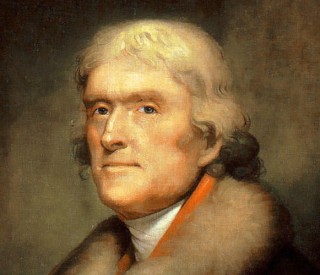 Jefferson was equally eloquent in return, praising the people of Cheshire for “this extraordinary proof of the skill with which those domestic arts which contribute so much to our daily comfort are practised by them.” He had a strict policy of not accepting gifts, however, and he made sure Elder Leland returned home with a personal check for $200 to cover the cost of the cheese.
Jefferson was equally eloquent in return, praising the people of Cheshire for “this extraordinary proof of the skill with which those domestic arts which contribute so much to our daily comfort are practised by them.” He had a strict policy of not accepting gifts, however, and he made sure Elder Leland returned home with a personal check for $200 to cover the cost of the cheese.
They put it in the East Room, and ate. And ate. And ate. I like cheddar cheese as much as the next guy; but a steady diet of it? No way. You can get too much of a good thing, after all. And the Cheshire Mammoth Cheese was a long time in disappearing.
No one can say when it finally vanished. It was present at Jefferson’s reception on New Year’s Day 1803, making the White House reek from one end to the other, too.
 It was still sitting out in March 1804, when one visitor delicately described it as “very far from being good.”
It was still sitting out in March 1804, when one visitor delicately described it as “very far from being good.”
Some accounts say its dried remnants were available to visitors as late as 1805; historians believe Jefferson finally had his servants unceremoniously dump the last of it into the Potomac River.
Now, an intelligent person would have learned a lesson from that experience: don’t put a gigantic, smelly food product in a public place.
But proving Santayana’s famous observation that “those who do not learn from history are doomed to repeat it,” the same thing happened again in 1835.
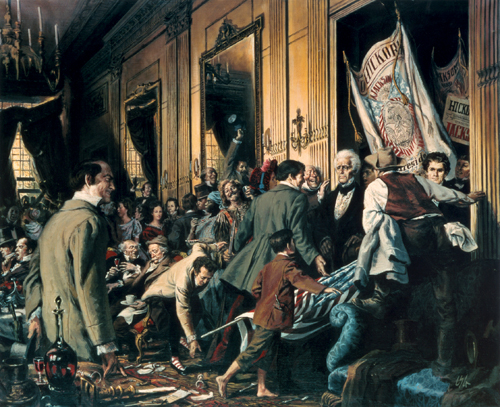 This time, a dairy farmer in upstate New York named Thomas Meachum wanted to show his appreciation to President Andrew Jackson. He remembered the Cheshire Mammoth Cheese, and decided to do it one better.
This time, a dairy farmer in upstate New York named Thomas Meachum wanted to show his appreciation to President Andrew Jackson. He remembered the Cheshire Mammoth Cheese, and decided to do it one better.
Meachum’s hunk of cheddar weighed 1,400 pounds (giving Old Hickory 166 more pounds of cheese to dispose of than was dumped into Jefferson’s lap). It also was engraved with the words “The Union, it must be preserved.” (Cheese engraving has become a lost art, it seems.)
Meachum was a generous man; Vice President Martin Van Buren and New York Governor William Marcy each got 750 pounds blocks of cheddar, too.
The Big Cheese (pun intended) was put on a schooner and sent to Washington, where it was wheeled into the East Room of the White House. Jackson tried to make sure everyone who visited him took some home with them (you could argue it was history’s first government cheese giveaway). But he still had a ridiculous mountain of the stuff on his hands.
Unable to move it, President #7 did what President #3 had done with his cheese: he left it in the East Room, probably with a sign saying, “Free Cheese. Take some — please, I beg you!”
If you’ve ever visited Washington in the summer, you know it is oppressively hot. This even bigger cheese made an even bigger stink than the original. And get this – it sat there for more than two years!
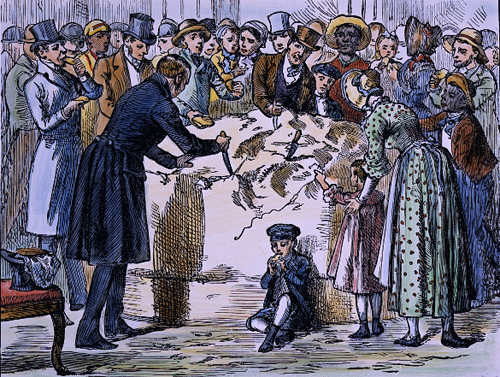 As Jackson’s second term was winding down in 1837, he came up with a way to finish it off. Knowing people love free food, he held a farewell reception. More than 10,000 folks flooded the White House, and choked down the very last bit of the cheese. Our Long National Fromage Nightmare was finally over.
As Jackson’s second term was winding down in 1837, he came up with a way to finish it off. Knowing people love free food, he held a farewell reception. More than 10,000 folks flooded the White House, and choked down the very last bit of the cheese. Our Long National Fromage Nightmare was finally over.
Except, it wasn’t. The cheese was gone, but its odor lingered. Like, a lot. Van Buren moved in after Jackson moved out. He fumigated the place and tried his best to get rid of it. But in 1838, long after the last bite was consumed, a Washington socialite wrote this in a letter to a friend:
“The White House has been put in order by its new occupant, and is vastly improved – (Van Buren) says he had a hard task to get rid of the smell of cheese, and in the room where it was cut, he had to air the carpet for many days; to take away the curtains and to paint and white-wash before he could get the victory over it. He has another cheese like that which General Jackson had cut, and says he knows not what to do with it. What a foolish thing for a man to have made such a present to him or anyone else!”
Van Buren wisely got rid of his own cheese as quickly as he could. In 1839 he auctioned it off with the money going to charity. Then he put down his foot: no more giant cheese gifts, period!
And so the days of saying, “Keep doing a good job, Mr. President!” with an absurdly large cheese wheel finally ended.
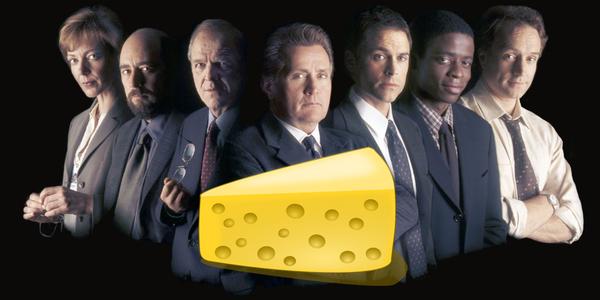 But the legacy endures. The TV series The West Wing had two episodes where the chief of staff used the 19th Century incidents as inspiration for an annual “Big Block of Cheese Day,” when kooks and crazies could visit the White House to discuss bizarre issues. They’re funny shows and worth watching.
But the legacy endures. The TV series The West Wing had two episodes where the chief of staff used the 19th Century incidents as inspiration for an annual “Big Block of Cheese Day,” when kooks and crazies could visit the White House to discuss bizarre issues. They’re funny shows and worth watching.
Thankfully for President Obama, and whoever succeeds him next year, 21st Century Americans have the option of expressing their happiness or dissatisfaction with the Chief Executive’s job performance through public opinion polling.
 The president may not like those poll results. But he’d like the rank odor of ripe cheese wafting through the White House a lot less.
The president may not like those poll results. But he’d like the rank odor of ripe cheese wafting through the White House a lot less.
Did you find this enjoyable or helpful? Please continue to join me each week, and I invite you to read Tell it Like Tupper and share your review!
Curious about Tell It Like Tupper? Here’s a chance to see for yourself. Take a sneak peek at a couple chapters in this free downloadable excerpt.

Great story, Mark. I can’t live w/o my cheese. Have to have it every morning or evening!!
Thanks for all your many great stories of rarity and unknown to most of us. Quite an education that you provide! Take care.
Karin
Glad you enjoyed it, Karin!
i love history
Thanks, Zoey. Great to hear from you. I’m from Joplin and went to school there!